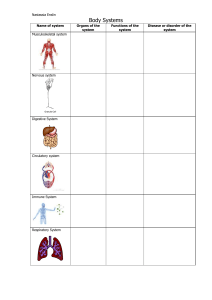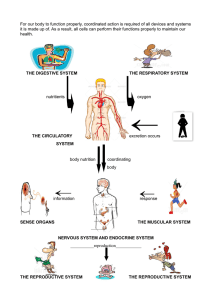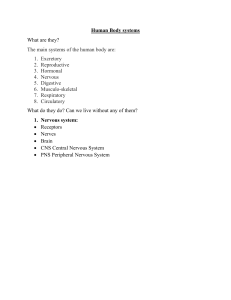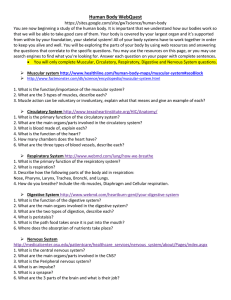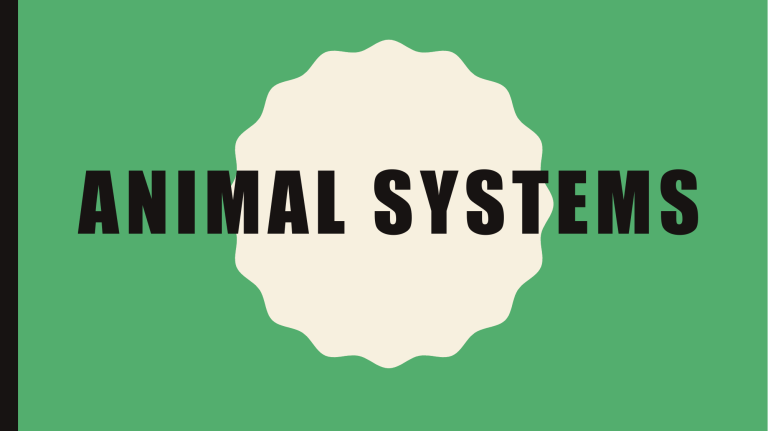
ANIMAL SYSTEMS RESPIRATORY SYSTEM: • Animals obtain oxygen from their environment with their respiratory systems. • The lungs of land-dwelling vertebrates gather oxygen from the air. • The gills of ocean-dwelling vertebrates filter oxygen from the water. • The exoskeletons of invertebrates facilitate the free diffusion of oxygen (from water or air) into their bodies. • The respiratory systems of animals also excrete carbon dioxide, a waste product of metabolic processes that would be fatal if left to accumulate in the body. CIRCULATORY SYSTEM: • Vertebrate animals supply oxygen to their cells via their circulatory systems, which are networks of arteries, veins, and capillaries that carry oxygen-containing blood cells to every cell in their bodies. • The circulatory system in higher animals is powered by the heart, a dense mass of muscle that beats millions of times throughout a creature's lifetime. • The circulatory systems of invertebrate animals are much more primitive; essentially, their blood diffuses freely throughout their much smaller body cavities. NERVOUS SYSTEM: • The nervous system is what enables animals to send, receive, and process nerve and sensory impulses, as well as to move their muscles. • In vertebrate animals, this system can be divided into three main components: the central nervous system (which includes the brain and spinal cord), the peripheral nervous system (the smaller nerves that branch off from the spinal cord and carry nerve signals to distant muscles and glands), and the autonomic nervous system (which controls involuntary activity such as the heartbeat and digestion). • Mammals possess the most advanced nervous systems, while invertebrates have nervous systems that are much more rudimentary. DIGESTIVE SYSTEM: • Animals need to break down the food they eat into its essential components in order to fuel their metabolism. • Invertebrate animals have simple digestive systems—in one end, out the other (as in the case of worms or insects). • But all vertebrate animals are equipped with some combination of mouths, throats, stomachs, intestines, and anuses or cloacas, as well as organs (such as the liver and pancreas) that secrete digestive enzymes. • Ruminant mammals such as cows have four stomachs in order to efficiently digest fibrous plants. MUSCULAR SYSTEM: • Muscles are the tissues that allow animals to both move and control their movements. • There are three main components of the muscular system: skeletal muscles (which enable higher vertebrates to walk, run, swim, and grasp objects with their hands or claws), smooth muscles (which are involved in breathing and digestion and are not under conscious control), and cardiac or heart muscles (which power the circulatory system). • Some invertebrate animals, like sponges, completely lack muscular tissues, but can still move thanks to the contraction of epithelial cells. SKELETAL SYSTEM: • Many invertebrate animals (such as insects and crustaceans) have external body coverings composed of chitin and other tough proteins, called exoskeletons. • Sharks and rays are held together by cartilage. • Vertebrate animals are supported by internal skeletons—called endoskeletons— assembled from calcium and various organic tissues. • Many invertebrate animals completely lack any kind of exoskeleton or endoskeleton. Consider soft-bodied jellyfish, sponges, and worms. ACCORDING TO WHAT YOU HAVE LEARNT ABOUT ANIMAL SYSTEMS… Choose a system and create a conceptual map talking about the most important ideas of the system… Look at the example:
